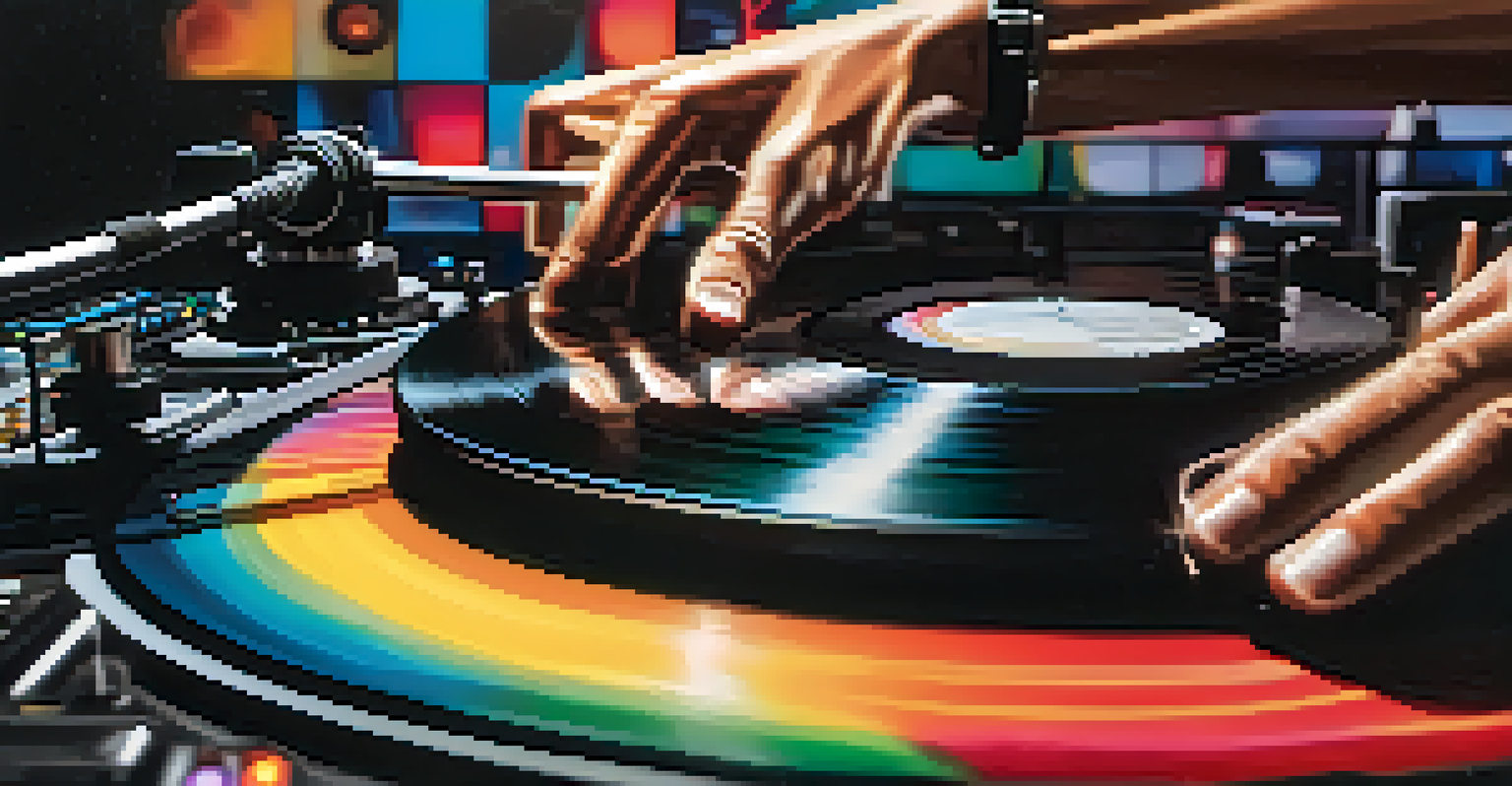Beatmatching: The Key Skill for Every Aspiring DJ

Understanding Beatmatching: The Basics Explained
Beatmatching is a fundamental skill that every DJ should master. At its core, it involves synchronizing the tempos of two tracks so they can be mixed seamlessly. This technique allows DJs to create a smooth transition between songs, keeping the energy flowing on the dance floor.
Music can change the world because it can change people.
Imagine you’re at a party, and the DJ suddenly switches tracks without a proper mix. The energy dips, and the crowd loses interest. That's where beatmatching comes into play; it helps maintain momentum and keeps the audience engaged.
Learning beatmatching can seem daunting at first, especially with all the technical jargon. However, with practice and a little patience, you’ll find it’s an invaluable asset that can elevate your DJing game.
The Importance of Tempo in Beatmatching
Tempo, measured in beats per minute (BPM), is the heartbeat of any track. Understanding the BPM of songs is crucial when beatmatching, as it determines how fast or slow a track will play. For instance, mixing a 120 BPM track with a 128 BPM track without adjustment will result in a chaotic blend.

Think of tempo as the rhythm of a dance; if everyone is moving to different beats, the dance floor will quickly empty. A skilled DJ knows how to match these tempos, ensuring every transition feels natural and keeps the crowd grooving.
Beatmatching Keeps the Energy Flowing
By synchronizing the tempos of two tracks, DJs can create seamless transitions that maintain audience engagement.
To get comfortable with tempo, try practicing with tracks that have similar BPMs at first. As you gain confidence, gradually introduce songs with varying tempos to challenge your skills and enhance your adaptability.
Tools and Techniques for Beatmatching
While beatmatching can be done manually, many DJs also use tools like DJ software and controllers that facilitate the process. These tools often feature visual aids that help you identify the BPM and phase of each track, making it easier to sync them up. However, relying solely on technology can hinder your growth as a DJ.
The more you practice, the better you get, the more freedom you have to create.
Consider beatmatching like learning to ride a bike. At first, you might use training wheels (technology) for support, but eventually, you need to learn how to balance on your own. The more you practice without assistance, the more proficient you'll become.
A great technique to improve your skills is to try beatmatching with your ears before relying on visual aids. This will sharpen your listening abilities and help you develop a deeper understanding of music structure.
Practicing Beatmatching: Tips for Success
Practice is key when it comes to mastering beatmatching. Start with a metronome or drum machine to get used to keeping time. Once you feel comfortable, transition to mixing with real tracks, focusing on matching their beats without using any software aids initially.
Another helpful tip is to record your practice sessions. By listening back, you can identify areas for improvement, such as timing issues or awkward transitions. This self-evaluation can be incredibly beneficial in refining your technique.
Practice is Key to Mastering Skills
Regular practice, including mixing without assistance and self-evaluation, is essential for improving beatmatching techniques.
Lastly, don’t hesitate to experiment with different genres. Every style of music has its unique rhythm and feel, and exploring various genres will enhance your versatility as a DJ. Plus, it keeps things fresh and exciting!
Beatmatching and Live Performance: Making It Work
In a live performance setting, beatmatching becomes even more crucial. The ability to mix tracks on the fly while reading the crowd’s energy can make or break a set. A DJ who can seamlessly blend songs will keep the audience dancing and engaged throughout the night.
Think of a live performance as a conversation with your audience; you need to listen and respond to their energy. If you notice the crowd is vibing with a particular style, you can adjust your set to maintain that momentum, utilizing your beatmatching skills to create smooth transitions.
To prepare for live sets, practice mixing in real-time with friends or small gatherings. This will simulate the pressure of a live audience and help you develop the confidence needed to perform in front of larger crowds.
Common Mistakes in Beatmatching to Avoid
Even experienced DJs make mistakes when beatmatching, but recognizing these pitfalls can help you avoid them. One common error is not listening closely to the tracks before mixing, which can lead to an awkward transition. Always take a moment to familiarize yourself with the songs you intend to play.
Another mistake is failing to adjust the tempo correctly. Sometimes, DJs will rush a mix or slow it down too much, causing the tracks to clash rather than complement each other. Remember, subtle adjustments can make a significant difference in the quality of your mix.
Balance Technology with Traditional Skills
Embracing digital tools while also mastering manual beatmatching enhances a DJ's creativity and authenticity.
Lastly, don’t let nerves get the best of you. It’s normal to feel anxious when performing live, but you must trust your skills. If something goes wrong, stay calm and recover gracefully; the audience will appreciate your ability to manage the situation.
The Evolution of Beatmatching in the Digital Age
In recent years, technology has transformed how DJs approach beatmatching. With the advent of digital DJ software, many beginners rely on automatic beatmatching features. While this can make the learning curve easier, it’s essential not to neglect the fundamental skills that define a great DJ.
Consider the digital age akin to fast food; it’s convenient and accessible but often lacks the richness of a homemade meal. Learning to beatmatch manually can provide a deeper connection to the music and improve your overall performance.

As you embrace technology, remember to balance it with traditional techniques. This hybrid approach will not only elevate your skill set but also set you apart in an industry that values creativity and authenticity.